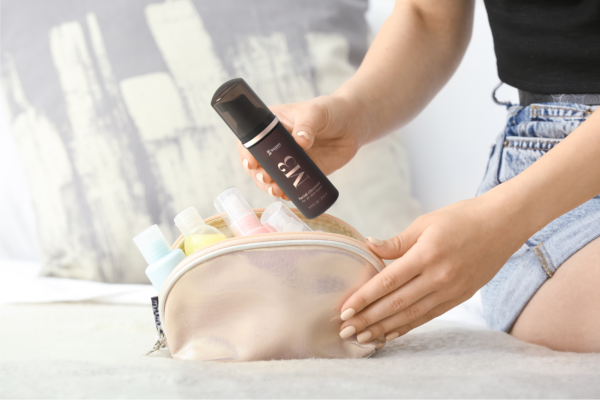
Sinds 2020 is de e-handel jaar na jaar aanzienlijk gegroeid. In maart 2022 steeg de verkoop via e-commerce met 27% ten opzichte van het voorgaande jaar, aldus McKinsey. Vrijwel elke consumentencategorie is door deze trend beïnvloed, en schoonheidsproducten en producten voor persoonlijke verzorging vormen hierop geen uitzondering.
In 2020 werd 16% van de wereldwijde verkoop van beautyproducten online gerealiseerd, en de verwachting is dat dit percentage de komende jaren alleen maar sneller zal stijgen[1]. Dit alles heeft ervoor gezorgd dat merken van schoonheidsproducten en persoonlijke verzorgingsproducten hun digitale activiteiten hebben opgevoerd en het ontwerp en de functie van hun producten opnieuw hebben geëvalueerd om rekening te houden met de veranderende koop- en gebruiksgewoonten van de consument.
E-commercetrends die een impact hebben op schoonheidsproducten en producten voor persoonlijke verzorging
Lichtgewicht, duurzaamheid blijven van het grootste belang
Ongetwijfeld het belangrijkste aspect van e-commerce design is ervoor te zorgen dat het product in één werkend stuk op zijn bestemming aankomt. Dit is vooral van cruciaal belang voor vloeibare producten, zoals het geval is voor veel schoonheids- en verzorgingsproducten.
Het gewicht draagt niet alleen bij tot de duurzaamheid van een oplossing, maar ook tot de verzendingskosten. Hoe zwaarder het product, hoe groter de kans dat een onderdeel beschadigd raakt als het tijdens het transport valt of wordt geraakt. Zwaardere producten vereisen ook meer middelen om veilig door de toeleveringsketen te worden getransporteerd, wat de verzendkosten opdrijft. Dit is een belangrijke reden waarom retailers zoals Amazon verpakkingscertificeringsrichtlijnen hebben opgesteld, om merken aan te moedigen producten en verpakkingen te ontwerpen die minder belastend zijn voor zowel verzenders als klanten.
Abonnement schoonheid boxen in opmars
Abonnementsdiensten zijn de afgelopen tien jaar steeds belangrijker geworden, maar de pandemie was een katalysator voor hun recente populariteit. Volgens Statista is 11% van de vrouwelijke cosmeticaklanten in de VS geabonneerd op een beautyboxservice en heeft nog eens 40% belangstelling getoond om er een te proberen.
Abonnementsdiensten op schoonheidsproducten stellen consumenten in staat nieuwe producten te ontdekken in het comfort van hun eigen huis. Deze abonnementen bieden consumenten ook een manier om nieuwe producten te ontdekken, waarbij ze vertrouwen op de expertise van deze diensten om dozen samen te stellen die aan hun persoonlijke voorkeuren voldoen. Millennials en Gen Z - de meest digitaal verbonden consumenten - zijn de belangrijkste gebruikers van abonnementsdiensten. Van degenen die zich abonneren op een beautybox, is 17% tussen de 18 en 29 jaar oud.
Verpakkingsoplossingen die merken moeten overwegen om voordeel te halen uit deze trends
Foamers
Schuimoplossingen bieden een aantal voordelen die zowel voor merken als consumenten belangrijk zijn. Ze zijn ideaal voor kleinere, reisvriendelijke producten zoals reinigingsmiddelen en make-up removers, maar ook functioneel voor tafelapplicaties zoals handzeep of body wash. Foamers zijn ook zeer geschikt voor handdesinfecterende middelen, die veel mensen nog steeds belangrijk vinden om bij de hand te hebben. Vooral voor gebruik onderweg zijn schuimpompen met een eenvoudige bediening in combinatie met een interne vergrendeling of overkap, zoals onze M3 pomp, van het grootste belang voor een schone, gecontroleerde uitgifte. Knoeien en algehele productproblemen kunnen iemands tijd gemakkelijk bederven wanneer hij onderweg is.
Daarnaast sluiten foamers ook goed aan bij de gedeelde duurzaamheidsbelangen van merken en consumenten. Consumenten gebruiken aanzienlijk minder water wanneer ze een schuimspuit gebruiken in vergelijking met andere doseermogelijkheden. Silgan DispensingUit eigen tests bleek dat consumenten 22% minder water gebruikten met schuimzeep in vergelijking met vloeibare handzeep. Naast waterbesparing passen we veel van onze ontwerpen aan met onze LifeCycle™-technologie om onze klanten meer volledig recyclebare oplossingen te kunnen bieden. Wereldwijd geloven consumenten dat recyclebare producten een van de meest effectieve manieren zijn om afval te verminderen.
Samplers
Hoewel de algemene bezorgdheid over gezondheid en veiligheid afneemt in vergelijking met de afgelopen jaren, zorgt het aanhoudende online koopgedrag ervoor dat consumenten minder vaak een winkel bezoeken dan voor de pandemie. Voor schoonheids- en verzorgingsproducten stelt de afwezigheid van een winkelervaring consumenten voor een aantal uitdagingen. Online beschrijvingen en recensies kunnen maar een beperkte hoeveelheid vertellen over producten die zijn ontworpen voor interactie met de zintuigen. Daarom bieden merken en retailers alternatieven voor sampling in de winkel, zoals producten in kleinere verpakkingen en sampler-style designs.
Deze richting sluit goed aan bij de interesses van de consument, vooral die van de jongere generaties, die minder geneigd zijn om slechts één merk te gebruiken voor een specifiek schoonheidsproduct, zoals een parfum. Zij houden van variatie en hebben verschillende opties, afhankelijk van een bepaalde stemming of gelegenheid.
Zoals bij elke dispenseroplossing mag de vorm niet ten koste gaan van de functie. Zelfs bij kleinere verpakkingen moeten merken ervoor zorgen dat kenmerken zoals de afvoersnelheid en soepele bediening aan de verwachtingen van de consument blijven voldoen.
Het valt niet te ontkennen dat de online winkelgewoonten van consumenten een aanzienlijke invloed hebben gehad op de sector van de schoonheidsproducten en persoonlijke verzorging. Niet alleen het type producten, maar ook de manier waarop die producten zijn ontworpen en verpakt, is de afgelopen jaren aanzienlijk veranderd. Als dit zo doorgaat, is het belangrijk voor merken om oplossingen te zoeken die duurzaam zijn, verkrijgbaar in verschillende formaten, vooral in kleinere hoeveelheden, en die weinig tot geen impact hebben op het milieu.
[1] Bron: Euromonitor International
